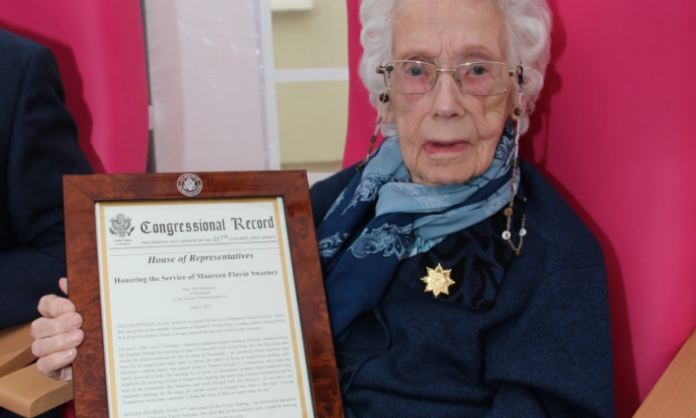By Sean Ryan
A 98-year-old Irish postmistress who unwittingly helped to save the world when her handwritten weather readings delayed D-Day has been honoured by the US government.
While most 21-year-olds spent the night of their birthday celebrating, Maureen Sweeney was painstakingly taking barometer and thermometer readings at the remote Blacksod weather station in County Mayo. Although Ireland may have been neutral in the Second World War it is now known from Ireland’s policy of friendly neutrality the then Taoiseach Eamon De Valera sanctioned the passing on of weather readings to the allies which proved pivotal to the date of D-Day in 1944. The readings from Mayo were crucial as they were the first sign of weather coming across the Atlantic two days in advance.
Leader of the D-Day invasion General Dwight D Eisenhower originally planned D-day for June 5th, 1944, but it was postponed after Maureen reported a dramatic drop in low pressure on June 3rd pointing to an impending storm over the invasion beaches. The storm that Maureen observed coming in from the Atlantic was set to hit the Normandy beaches 500 miles away in two days on June 5th, the original date for D-Day. Maureen’s observations forced Eisenhower to stall the 160,000 troops on nearly 7,000 ships, along with thousands of airmen, as stormy conditions and poor visibility would have played havoc with the landing.
Speaking on a special RTÉ documentary on Maureen’s role in the D-Day landings in 2019, 96-year-old D-Day veteran Joe Cattini said the 160,000 men who landed in Normandy in France on D-Day owed a debt of gratitude to Maureen Sweeney. He said: “We owe a lot to Maureen of the west of Ireland, us who invaded France on D-Day because if it hadn’t been for her reading of the weather we would have perished in the storms.” Kerry native Maureen also told the same documentary how she answered an ad for a post office assistant in Blacksod but she only realised when she got to Mayo that part of her duties was to carry out weather observations for the Met Office.
“It was only every six hours pre-war but then they found out our weather reports in (Blacksod) were the first indication of good or bad weather coming in and they made it an hourly. You would only have one finished when it was time to do another. The reports from here showed the first changes coming off.” At 1pm on 3rd June 1944, 21-year-old Maureen was first to forecast a severe Atlantic storm, which led to a change of plan in one of the world’s biggest military operations.
She had to record the pressure, the temperature and the water vapour and transmitted it from Blacksod to Ballina where it went to Dublin and then directly to the meteorological office in Dunstable in the UK. Looking back now, Maureen said she had no idea in June 1944 that her readings halted the invasion. She said: “Poor old Eisenhower, he was commander in chief, all the proposals had to go through him. He had the whole world, I suppose, to consider.”
Maureen’s updated readings were passed on to General Eisenhower who gave the signal to invade on June 6th . Critically, this was also a reading which the Germans were unable to gauge as they had no weather ships in the north Atlantic so they could not see the change in the pressure. Speaking in a recorded interview with her grandson Fergus Sweeney in 2014, Maureen said: “Eisenhower was making up his mind about whether to enter France or not. He was very divided but when he saw the report from Blacksod Point it confirmed he made the right decision.
“That report was sent from here on the 3rd June and the following morning there was a query at around 11 o’clock. And then there was a second query. A lady with a distinct English accent requested me to ‘Please Check. Please Repeat!’ We began to look at the figures again. We checked and rechecked and the figures were the same both times so we were happy enough then”. Maureen added with pride, “they relied on our weather forecast. It’s something you’ll remember for a lifetime.”
Now almost 80 years later Maureen has been honoured by the US House of Representatives for her heroic act. Maureen was honoured at Tí Aire nursing home in Belmullet in County Mayo where she now lives. A letter was read out from the World War II museum in New Orleans, Louisiana, as well as a personal note from US Congressman and retired 3-Star Admiral Jack Bergman (Michigan First District), who is the highest ranking veteran to ever serve in Congress.
The special recognition, which has been awarded since 1789, entitles Maureen to receive a proclamation noting her accomplishments, and will be placed in the US Library of Congress for perpetuity. A special medal in recognition of Maureen’s ‘Laudable Actions’ was placed on her lapel and there will be music and poetry performed for Mayo’s D-Day heroine.








